In 1908, John Moses Browning designed a cartridge he called the 380 Automatic Colt Pistol, but which we know today as the 380 ACP. The Germans called the cartridge the 9mm Kurz, with the Italian name for the same round being the 9mm Corto. Both of those foreign words mean short, with the 380’s metric nomenclature being 9x17mm, compared to the 9x19mm sizing of the 9mm Luger (or 9mm Parabellum).
Once snubbed for being underpowered, at least in the American market, modern bullet technology has granted new life to the 380 ACP. As a result, we have recently witnessed several manufacturers introducing new 380 ACP pistols. We grabbed two of the newest models as well as a classic piece against which we can measure the latest handguns.
The first is the Ruger Security 380 Lite Rack 03839, $296. It shoehorns 10- or 15-round magazines into a lightweight package, along with the Lite Rack system and some great sights.
The second is the Smith & Wesson M&P 380 Shield EZ 3008882, $400. Also designed to be easy to rack for those with diminished hand strength, the Shield EZ includes a grip safety hinged at the bottom and many of the features found on the very popular M&P 9mm series.
The classic entry in our test is a kindly used Beretta Model 84BP, $400. Essentially a scaled-down version of the Beretta Model 92 9mm Luger, this particular Model 84 allows the pistol to be carried hammer down where it can be shot as a true double action. Or it can be carried cocked and locked for single-action operation.
Our test shooters fired this trio side by side at American Shooting Centers in Houston. For accuracy comparisons, we shot at 15 yards with Hornady Critical Defense FTX 90-grain rounds, 90-grain Federal Personal Defense Hydra-Shoks, Black Hills 90-grain JHPs, and Armscor 95-grain FMJs. Additionally, we fired speed drills at 5 and 8 yards. Here’s what we found:
Beretta Model 84BP 380 ACP
$400
Gun Tests grade: B-
This pistol shot everything well and was, by a slight margin, the most accurate pistol with the ammo tested. It also had the most felt recoil of the three, and there was a problem with the recoil spring.
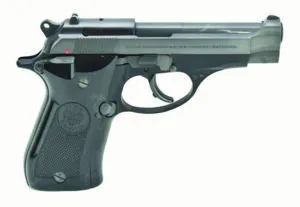
| Action Type | DA/SA, hammer fired |
| Overall Length | 6.8 in. |
| Overall Height | 4.8 in. |
| Maximum Width | 1.38 in. |
| Weight Unloaded | 1.25 lbs. |
| Weight Loaded | 1.73 lbs. |
| Slide Material | Steel |
| Slide Retraction Effort | 15.4 lbs. |
| Receiver Material | Alloy steel |
| Finish | Blued |
| Front Strap Height | 2.1 in. |
| Back Strap Height | 3.2 in. |
| Barrel Length | 3.75 in. |
| Grip Thickness (Maximum) | 1.38 in. |
| Grip Circumference | 5.6 in. |
| Magazine | One 13-round |
| Rear Sight | Drift adjustable black notch |
| Front Sight | Fixed black blade |
| Sight Radius | 4.9 in. |
| Trigger Pull Weight Double Action | 7.4 lbs. |
| Trigger Pull Weight Single Action | 3.8 lbs. |
| Trigger Span Double Action | 3.0 in. |
| Trigger Span Single Action | 2.7 in. |
| Safeties | Magazine, thumb |
| Warranty | 2-year limited |
| Telephone | (301) 283-3191 |
| URL | BerettaUSA.com |
| Made In | Italy |
Beretta is a well-known player in the military firearms world, and it has been for centuries. Beretta was founded in 1526 and is the oldest continually operating firearms manufacturer. The current Beretta corporation contains many brands, such as Sako, Benelli, and Tikka, making Beretta a true global firearms powerhouse.
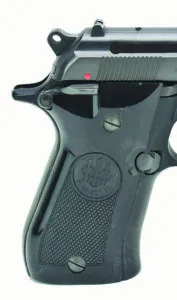
In 1985, the U.S. military wanted to field a 9mm pistol in the interest of ammunition compatibility with other NATO countries. The winner of the competition was Beretta, and the 9mm handgun became known as the M9, whose forebearer was the Model 92.
Designed in 1975, the Beretta Model 92 saw its way into other platforms before becoming the M9. The Models 81 and 82 are scaled-down versions of the Model 92 but chambered in 32 ACP. The Models 83, 84, and 85 are all chambered in 380 ACP, with differences in magazine capacity and barrel lengths. More currently, Beretta announced a Model 80X in 2023 with a completely redesigned grip, trigger guard, and feed ramp and a Pic rail.
Our 380 sample is a well-maintained Model 84 dating to the early 1980s, though we are not sure of the exact date. Databases of Berettas, their markings, and their production dates are available, none of which match up with our pistol. That said, we are reasonably certain of the original purchase date and stopped our historical research efforts there. Ours is marked “PB” on the right side of the receiver and sports the 3.81-inch barrel. It has lightly checkered plastic grips and the early rounded trigger guard.
The Model 92s come in a variety of configurations, mainly differing in the thumb-actuated switch on the slide. It can be purchased as decocker, a safety only, a combination of both, or none of the above. In contrast, our Model 84 has a frame-mounted safety that allows the pistol to be carried several ways. First is hammer down on an empty chamber (not recommended) and on Safe or on Fire. Next comes hammer down on a loaded chamber on Safe or Fire. This places the initial trigger stroke in double-action mode. This variant also allows the pistol to be carried cocked and locked, utilizing a very smooth single-action trigger press. The thumb safety is even ambidextrous, making things simple for left-handers. However, the magazine release can’t be changed to either side, but we never found that to be an issue, just use the left-hand index finger to release the magazine. The slide release is also left side only.
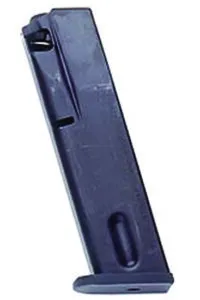
The trigger impressed us. Total movement on the double-action trigger pull was about 1.125 inches and very smooth. Maybe that has something to do with its age, but the owner doesn’t ever remember the trigger pull being heavy. Required compression of the double-action trigger pull was only 7.4 pounds. Single action was even better, with only 3.7 pounds of pressure required to move the trigger less than 0.25 inch. It even has an overtravel stop built into the back of the trigger shoe.
The slide is open topped, as we would expect with most Berettas. That lets dirt get into the action, and it also lets dirt fall out, so you decide if that is a good thing or not. The extractor is external, and the ejector is pinned to the frame. The sights are typical of 40 years ago and not up to the standard we see on the other two pistols in this test. The rear is small, black, and drift adjustable. The front is small, black, and machined into the front of the slide. Since this pistol was designed and produced long before the advent of pistol mounted optics, no provision was made for the mounting of such on the Model 84.
The frame definitely shows a 1980’s design. The grips are almost smooth and plastic. Neither the frontstrap or the backstrap have any type of surface that would aid in grip retention. The magazine well does not show any type of bevel, and hitting the mag well in a hurry takes practice. The designers were kind enough to build in a small beavertail that protects the web of the hand from hammer bite. That said, the edges of that beavertail are a little sharp, and we would love to see them a bit more rounded. The safety is easy to reach and activate. Our particular version has a magazine safety, meaning the trigger will not work unless a magazine is inserted.
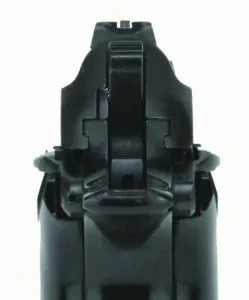
As mentioned, the alloy frame is about 40 years old and is beginning to show a problem in that one of the surfaces is starting to peen. This comes into play when we disassemble the pistol. Takedown is supposed to be easy. Check to make sure the pistol is empty — several times. Lock the slide to the rear and push the takedown lever lock pin from left to right using the left index finger. That allows the takedown lever to rotate 90 degrees counterclockwise. Last, lower the slide release and move the top end off the frame from rear to front. That is, unless the frame has started to peen. There is a shelf at the rear of the dust cover through which the recoil spring guide rod is designed to slide. Ours has taken enough of a beating over the years to allow the guide rod to be pinched at that point and not complete its travel forward. We keep watching for this to affect proper function of the pistol, but that hasn’t happened yet. What it does do is trap the guide rod in the frame and resist proper disassembly. We had to tap the rear of the slide several times to free the rod and complete the process. We plan to see if a good machinist and a proper mill could smooth that out for us.
Our Team Said: Though a bit long in the tooth, the Beretta Model 84 is a very smooth-shooting mid-sized high-capacity 380 that proved to be the most accurate pistol in this test. The option to shoot with a true single-action trigger helped there. It also generated substantially more recoil than the other two. With the smooth frontstrap and backstrap, we actually felt the pistol torquing in our hands and had us pushing shots a bit to the left. Of course, the 40-year-old recoil spring might have contributed to that. We also note that the newest Model 80X from Beretta has stippling on the frontstrap and backstrap, thus eliminating one of our big gripes. The Black Hills 90-grain posted the tightest groups with a five-shot average of 1.69 inches.
| 380 ACP RANGE DATA | |||
| Hornady 90-grain FTX | Beretta Model 84 | Ruger Security 380 | Smith & Wesson Shield EZ |
| Average Velocity | 978 fps | 912 fps | 955 fps |
| Muzzle Energy | 191 ft.-lbs. | 166 ft.-lbs. | 182 ft.-lbs. |
| Best Group | 2.07 in. | 1.59 in. | 1.98 in. |
| Average Group | 2.39 in. | 1.91 in. | 2.30 in. |
| Federal Personal Defense 90-grain Hydra-Shok JHP | Beretta Model 84 | Ruger Security 380 | Smith & Wesson Shield EZ |
| Average Velocity | 1012 fps | 959 fps | 963 fps |
| Muzzle Energy | 205 ft.-lbs. | 180 ft.-lbs. | 185 ft.-lbs. |
| Best Group | 1.60 in. | 1.74 in. | 2.74 in. |
| Average Group | 1.95 in. | 2.30 in. | 2.81 in. |
| Black Hills 90-grain JHP | Beretta Model 84 | Ruger Security 380 | Smith & Wesson Shield EZ |
| Average Velocity | 952 fps | 912 fps | 945 fps |
| Muzzle Energy | 181 ft.-lbs. | 166 ft.-lbs. | 179 ft.-lbs. |
| Best Group | 1.49 in. | 2.26 in. | 1.85 in. |
| Average Group | 1.69 in. | 2.41 in. | 2.05 in. |
| Armscor 95-grain FMJ | Beretta Model 84 | Ruger Security 380 | Smith & Wesson Shield EZ |
| Average Velocity | 992 fps | 975 fps | 996 fps |
| Muzzle Energy | 208 ft.-lbs. | 190 ft.-lbs. | 209 ft.-lbs. |
| Best Group | 1.55 in. | 1.98 in. | 1.65 in. |
| Average Group | 2.12 in. | 2.73 in. | 1.97 in. |
How we tested: We fired these pistols at American Shooting Centers in West Houston. Accuracy was tested at 15 yards by shooting multiple five-shot groups from a well-sandbagged Caldwell Pistolero shooting rest (MidwayUSA.com Product No. 517357, $28) assisted by a Mini DRC Fortune Cookie from Wiebad.com ($75, Product No. MINIFC). We found our ammo through Ammoseek.com, firing Hornady Critical Defense FTX 90-grain rounds, Federal Personal Defense 90-grain Hydra-Shoks, Black Hills 90-grain JHPs, and Armscor 95-grain FMJs.
| DRILL NO. 1 DATA | |
| Pistol | Single Shot Average Time |
| Beretta 84 | 0.86 |
| Ruger Security 380 | 0.92 |
| S&W Shield EZ | 0.78 |
Process: Fire one shot from low ready at A Zone target (5 by 11 inches) placed at 5 yards. Numbers are averages for eight repetitions. Times are in seconds.
| DRILL NO. 2 DATA | |||
| Pistol | 1st Shot | Split Average | Total Time |
| Beretta 84 | 1.1 | 0.326 | 1.73 |
| Ruger Security 380 | 1.08 | 0.364 | 1.81 |
| S&W Shield EZ | 1.09 | 0.268 | 1.59 |
Process: Fire three shots from low ready at A Zone target (5 by 11 inches) placed at 8 yards. Numbers are averages for three repetitions. Times are in seconds.
Written and photographed by Joe Woolley, using evaluations from Gun Tests Team members. GT




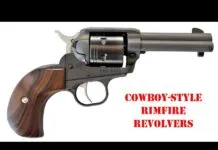





















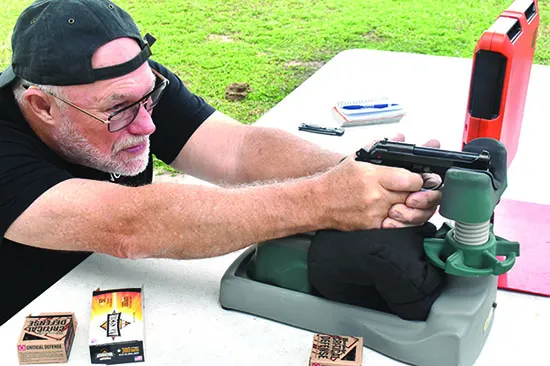


I have the FS (squarish trigger box) bought in 1993. Yes, it’s old school a bit too big for concealed carry but is like it was made for my hand. And you are right about improved ammo over the decades making 380 a real contender again. Oh and after a few thousand rounds, NEVER has it failed to fire in any way. I have both Mec Gar and Beretta mags.
I love that thing… I see they have a new and improved one the X80 that’s worth looking at. But basically all the shooting guts appear to be the same…